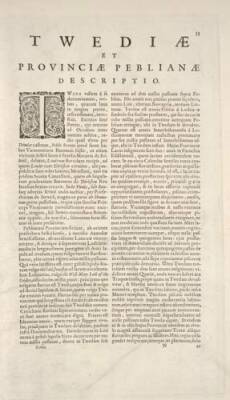Blaeu Atlas of Scotland, 1654
| Field | Content |
|---|---|
| Name: | Blaeu, Joan, 1596-1673 |
| Title: | Teviotia. Twediae Et Provinciae Peblianae Descriptio |
| Pagination: | 33 |
| Zoom view: | Click on the image to view in greater detail |
| 36 / 162 Scroll through pages: 


 | |
Translation of text:
DESCRIPTION OF
TWEEDDALE
AND
THE PROVINCE OF PEEBLES (Section Note)
The Tweed flows through a valley named from itself, full of sheep whose wool commands a high price. It is an outstanding river, rising far inland to the west among mountains, carried down as if in a straight channel through the castle of Drumelzier and the centre of Peebles, which has its own Sheriff Lord Yester, as too the neighbouring Selkirk has its from the family of Murray of Fallowhill. Then it takes in the Leader Water, at which Lauder may be seen, with Thirlestane; there is the very beautiful house of John Maitland, quite recently Chancellor of Scotland, who for his singular prudence was created Baron Thirlestane by King James VI. From there the Tweed, increased below Roxburgh by the foreign waters of the Teviot, runs through the Prefecture of Berwick, possessed in large part by the family of Hume and in which the head of that family now exercises the jurisdiction of Sheriff; and it slips into the sea, very productive of salmon, below Berwick, the most fortified town in Britain, of which I have spoken.
The Province of Peebles is bounded on the east by the prefecture of Selkirk, on the south by the Stewartry of Annandale, on the west by the sheriffdom of Lanark, and finally on the north by Lothian. In the middle in length it stretches from Eric Stane to the stream which is in the vernacular called Barthorburn, more or less twenty eight miles. At its widest, between the cleft of the icy rock, in the vernacular the Cauldstaneslap, to the eastern lake of the Lobii, in the vernacular ‘the West-Mary Loch of the Colaebes’, it extends for eighteen miles. The principal river by which it is irrigated is the Tweed, whose fount and source is at Eric Stane and the place commonly called Tweed-cross. This river runs through the whole province at its longest; from it the whole province was once given the name Tweeddale. Beyond this river to the north there are several streams worth mentioning. First is Holms Water, which Biggar Water takes in before it slips into the Tweed, a little below Drumelzier. Next there is Lyne Water, running down from the Cauldstaneslap for nine miles, until it discharges into the Tweed two miles above Peebles. This stream is crossed by three stone bridges, one at Lyne, the second at Newlands, the third at West Linton. Third is Peebles Water, flowing from the fringes or boundary of Lothian, measuring in its course eight miles before it reaches Peebles, where it flows into the Tweed. Fourth is Innerleithen Water, coming from the foot of the Lothian hills for six miles as far as Innerleithen, where it flows into the Tweed. The more noteworthy lakes in this Province are two: one in the parish of Eddleston, which they call the west lake. In it about the first of August, such a great quantity of river fish, especially eels, abounds that, in a favourable wind (that is, one blowing from the head of the lake in the direction of its flow, where a little river breaks out), the local people, gathered there for the fishing and standing ready in the outflow of the lake for the opportune moment of taking them, are sometimes scattered by the force of the fish as they burst out, losing the footholds which they have endeavoured to make and strengthen for themselves. Nonetheless they catch in nets and wicker-baskets an incredible number of eels and other river-fish, and make no small profit from it. The other lake, which they call Genens, occupies the summit of a mountain of the same name, and is a mile long and half a mile wide; its outflow falls into Annandale at a huge cliff, twelve hundred feet from the top of the mountain to the plain that joins the foot of the mountain; there fish are often found which have fallen from the cliff to their death. Beyond the Tweed to the south are two noteworthy streams, viz. Quair Water, whence the castle of Traquair takes its name, near which it enters the Tweed; and Manor Water, rising from a spring of the same name, which slips into the Tweed a little below Manor Church. What makes the Tweed an especially notable fishery is the great abundance of salmon, ascending it from the sea in summer and staying there for the greater part of the year; some are caught a mile below the head of the Tweed. In this as in other rivers and streams of this Province there is a very abundant supply of fat and healthy trout and other river fish. This region enjoys a temperate climate and for the most part clear


